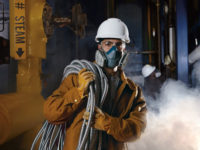Purchase your PPE based on product mapping

Administrators of industrial facilities can use product mapping when selecting safety products, factory floor equipment, office supplies, or just about anything that is purchased on a regular basis. It’s a matter of mapping out your selection criteria. Product maps can be used to analyze PPE based on dimensions such as durability, cost, compliance and comfort.
Product mapping basics
According to Marketeck Company, a market research organization, a product map is a graphic representation of the ways people perceive products, in terms of underlying attributes, as well as an aid in understanding their preferences.”
The benefits
To focus on the benefits of product mapping in an industrial work situation, let’s analyze cleaning chemicals used in professional cleaning in an industrial facility. Our goals in conducting the product map are to reduce costs, reduce storage needs, use fewer cleaning products, and streamline ordering. The same goals can apply to your PPE supply, for instance.
The first step is to inventory all the products now being used. Many “traditional” cleaning products are in use even though the company has been attempting to follow a green cleaning program for more than five years. So all of the traditional cleaning products should be eliminated; they will not be analyzed because they will no longer be used.
Next, divide all of the remaining products into categories based on how they are used: window cleaners, all-purpose cleaners, floor cleaners, etc. In our example we find we have several different brands of all-purpose cleaning solutions, with many from the same manufacturer. We can build our first product map based on these products.
Our “jury” will consist of building administrators along with a team of cleaning workers who use the products every day. We find in mapping the products’ performance that they are all about the same. Costs are also found to be fairly comparable.
So we take a closer look and analyze the products (A through E) by dilution ratios (chemical to water), which gives us a product map that looks like this:
Highest Concentrated: Product E 1:6; Product A 1:5; Product D 1:3; Product B 1:3; Product C 1:2.
One product (E) can be diluted so much further, and because performance and “sticker” price on all five products are the same, we realize that selecting the product with the highest dilution ratio: 1) Is cost-effective; 2) Helps us use storage space more efficiently; 3) Means we do not have to train workers on five different cleaning solutions; and 4) Helps streamline ordering.
Plus, it may also allow us to purchase products in bulk orders, resulting in further manufacturer or distributor discounts.
Required mapping
Product mapping is conducted in all types of settings with all types of organizations, and it is rarely performed once and forgotten. Many large universities, for instance, will “map” products every few years, comparing price and performance of what they are using to new products selected for the same tasks. Product mapping is one of the most effective ways to find the products that work the best and are most cost-effective.
Looking for a reprint of this article?
From high-res PDFs to custom plaques, order your copy today!




